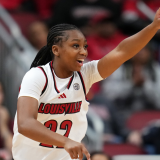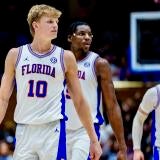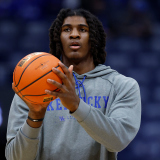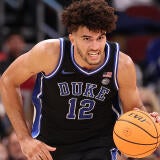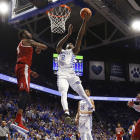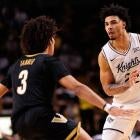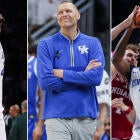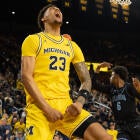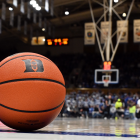NBA Draft 2018: The six college basketball players with the most agonizing stay-or-go decisions
Making the case to return to school, or leave for the NBA for guys like Kentucky's Jarred Vanderbilt
More than 100 college basketball players -- freshmen through juniors -- have already declared early for the 2018 draft. Many of these players, of course, will return to school. Of the crop that's opted to test the waters, only a handful have true on-the-fence decisions. Within that small group, a few players in particular are fascinating. Below, I've highlighted some men who have compelling reasons to leave -- and potentially stronger reasons to return.
College basketball would no doubt benefit in a significant way if some or most of the players listed here opted to come back for another season. The chances all six guys do that, however, is slim. All of these players, as of this story's publishing, have yet to sign with an agent.
What's the timeline for all of this? Here are the dates you should know: All draft declarations must be made by 11:59 p.m. ET on April 22. The NCAA deadline to withdraw from the draft process and return to school is May 30. The NBA's annual pre-draft combine will again be held in Chicago, starting on May 16. The 2018 Draft will be held in Brooklyn, N.Y., on June 21.
In alphabetical order, here are six players facing fascinating choices about that timeless question, famously posed by The Clash: Should I stay or should I go now?
Tyus Battle, Syracuse
Let's start things off with a player who I am surprised has not even publicly declared for the draft as of this story's publishing. With that, I'm inclined to think Battle, whenever he announces, will either say he's gone for good (i.e., no "testing the waters") or is bypassing all of this and will return to Syracuse.
And if those are the two options, it's only reasonable to lean with the former.
But Battle's got a curious choice. He's projected by some to be a first round pick now. After helping Syracuse make the Sweet 16, Battle's stock clearly got a nice bump in March. He averaged 19.2 points, 2.9 rebounds, 2.1 assists and 1.5 steals for the Orange. He was the most played player in college basketball this season. Battle played in 96.2 percent of Syracuse's minutes, more than anyone else in Division I.
So his numbers were helped with that much playing time, but I'll also note he shot 45.2 percent from 2 and just 32.2 from 3. At 6-6 and weighing approximately 210 pounds, Battle has the physique of an NBA player and probably will bulk up well, and quickly, at the next level. If he comes back, his numbers might stay level -- but could he become even more efficient? If that happens, and if Syracuse can be better next season (which I think happens), Battle could bump from that 28-34 range to potentially that 20-26 slot.
Ultimately, he was a good-not-great college player. Another year playing for a Hall of Fame coach could vault him to a higher level. But since it's Syracuse, and since that 2-3 zone doesn't do much to boost a prospect's chances on the defensive end, Battle's got a lot to think about.
Jacob Evans, Cincinnati
Cincinnati's 2018-19 season doesn't hinge on Evans' choice here, but the Bearcats would have legitimate Final Four hopes if he came back. We're talking about a team that went 31-5, was a No. 2 seed, finished fourth in KenPom and would have had a great shot at making it to San Antonio if not for an all-time, 22-point collapse against Nevada in the second round.
The Bearcats lose two key pieces (Gary Clark, Kyle Washington), which would make Evans the unquestionable star -- and probably the American Athletic Conference's preseason pick for player of the year -- if he returned. Evans (13.0 ppg, 4.0 rpg, 3.1 apg, 42.7 FG percentage) is going to get looks in the first round. If that guarantee money is there, it's going to be hard to get him to come back to college. From what I gather, Evans could be picked anywhere from 23rd to about 35th or 36th at this stage.
The workouts and interviews, for better or worse, will go a long way to determining his fate. There's a lot for him to consider.
"It's hard to tell," one source told CBS Sports about trying to pin down what Evans would do. "All kids want to go if they can. He's smart and not desperate. So it depends on the feed back from the NBA -- not agents. Does he get a Chicago invite? If so, how does he perform?"
A first-round guarantee could be the clincher. We've got the Bearcats ranked 25th as things stand now, without him in the mix.
Jerome Robinson, Boston College
The best player you haven't seen enough of. Robinson was a force last season, averaging 20.7 points, 3.6 rebounds, 3.3 assists and shooting 41 percent from 3-point range. He was a First Team All-ACC honoree. If he comes back for a senior campaign he could (should?) be the preseason ACC player of the year.
A few factors make Robinson's choice difficult. He's got a pro's body and a pro's skill set right now. But he's not projected as a top-20 pick. At his age, can he expect to be taken, say, at least seven spots higher come 2019? These nebulous, sliding-scale type of forecasts are what players sometimes weigh when evaluating their chances of being drafted. For Robinson, if it's between spot 28 and 32, maybe you take the guaranteed first round money, but all told it's not a huge difference. However, if you're around spot No. 35 this year but could bump up to 22 or 23 in a year? That's sizable.
"I think if he gets assurances from teams that he's a first round pick he stays," one source at Boston College told CBS Sports. "If not he comes back. But it's also hard for him. If he comes back next year and averages 18 points, shoots 47 percent from the floor, and 38 percent from 3, he 'regressed.'"
A good point, that. But if Boston College can go from a 19-win season to 23 or 24 next year then winning more games could in theory offset any reasonable regression to the mean.
Robinson isn't the only Boston College player who's choice is up in the air. His backcourt mate, Ky Bowman, is also testing the waters. And given his conditioning and athleticism, Bowman will probably test well. All told, no program has as much on the line in the next few weeks with multiple players weighing their pro potential like BC. With both players back, the Eagles should contend for the NCAAs. Without either, reaching the NIT would be a stretch.
Zhaire Smith, Texas Tech
The best athlete of any player listed here. One source said Smith could easily win over a team, get picked in the first round this year but probably wound wind up camping out in the G League for most of next season. I could easily see that. Smith has buzz about his ability, but if he's able to expand his game and create some offense for himself, then he's got a shot at the 2019 lottery.
The toss-up for Smith is if he'll ever be as highly regarded as he is now.
If he goes back to Texas Tech he should be the primary attraction on a Red Raiders team that would, potentially, again, be a top-three team in the Big 12. College basketball would absolutely be bettered by having Smith come back and chew on some rims.
Defensively, he's ready for the NBA. Athletically, there's no question. But he can't do enough with the ball in his hands at this point to warrant putting him on an NBA floor come November or December. Smith is caught in that zone where everything about him except the one thing that's most important -- providing consistent offense -- is NBA-ready. Will he acknowledge that, get in the gym, and return to Lubbock? Or will he take a chance on his God-given skills and try to adapt at the highest level and chase money now? It's hard to see him slipping out of the first round.
Omari Spellman, Villanova
When looking at each player's situation, it's important to remember that age can be a factor for some guys' decisions. If he goes, Spellman could be a case study on that. He's only played one year of college basketball, but his clock got set back a year unexpectedly. He'll be 21 come July.
Spellman was ruled academically ineligible for 2016-17, forcing him to redshirt. Now, that redshirt year might well have been the thing that allowed him to have one of the 10 best freshman campaigns in 2017-18. He cut weight, matured his game and his mind, and wound up as the second-most accurate 3-point shooter on the most destructive 3-point-shooting team in college basketball history.
A reminder that he's 6-8. His style very much suits the current NBA. And he's a good defender, too. Playing for a national champion also helps guys getting NBA looks even before the NCAA Tournament starts.
Spellman averaged 10.8 points, 8.0 rebounds and 1.5 blocks last season. He played 28 minutes per game and shot 43.3 percent on 150 attempts from 3 -- just a tick below Mikal Bridges' 43.5 clip (on a team-high 239 takes). He had a quality year but could be a menace next season at Villanova. With him back (and potentially Donte DiVincenzo as well; the Big Ragu is another player with a lot to mull over all of a sudden), Spellman would be viewed as one of the 20 best players in college basketball heading into the 2018-19 season.
Could he boost his stock further next year? I think so. On the other hand, is he destined to be a guy taken in the early second round, no matter the year? If that's the case, you could argue easily either way: return to college, dominate again, and live the glory for another 12 months. Or: go get the money now since your situation isn't probable to drastically improve.
Jarred Vanderbilt, Kentucky
To me, the second most interesting call of anyone out there. (Spellman being at the top of the list.) Vanderbilt played only 14 games last season because he missed the first 17 and last six due to injury. The former was due to a left foot issue, the latter because of an ankle injury.
Vanderbilt's very talented. He's got such a ceiling that he could turn into one of the 15 best players, I think, in college basketball next season. In limited time last season, Vanderbilt averaged 5.9 points and 7.9 rebounds in 17 minutes per game. Kentucky of course will bring in another loaded freshman class -- John Calipari might get guard Ashton Hagans to reclassify and play next year -- and there's a lot of frontcourt players trying to fit into shifting roles, but Vanderbilt's choice is fascinating.
Will his injuries be cause for enough red flags that he slips 10 spots or so in the draft? Is his limited game tape also going to hinder him? If so, does he return to Kentucky, hope to stay healthy for 30-plus games, and show how good he really is? If that happens, the lottery in 2019 could be on the table. Key to keep in mind that he would still be "sharing" minutes, potentially, with potential sophomore returnees P.J. Washington and Nick Richards, plus the addition of freshman forward E.J. Montgomery.
Of all the players listed here, Vanderbilt's is probably the toughest because he has the most mystery regarding his future at either level.


